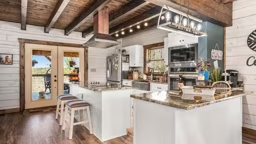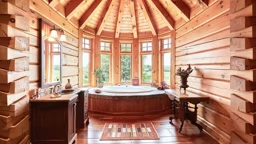
Outdoor living spaces for log homes can offer additional usable exterior square footage, protection from the heat, cold and precipitation, and even help manage heating and cooling on the interior of your home. And of course, they are a natural fit for rustic homes, typically blending the architecture of the home with natural elements and the topography of the lot.
The choices available today can seem overwhelming; however, by narrowing them down and really designing these spaces to tailor your needs and location, you will gain spaces that are individualized and efficient. While in the design phase of your home, consider whether these spaces will be incorporated during the build, or at a later date. Share your ideas with your designer, builder, landscaper, electrician, etc.
Many of these spaces are developed over a period of time, but by "roughing in" water, electricity and covered roofed areas early on, you can save time and money over the long haul and stay on the designed plan.
So how do you know what's right for your home? By balancing your budget and your got-to-have wish list. Many outdoor living spaces combine various elements together, and may be both public and private spaces, much like the interior of your home.
Consider your favorite vacation spots and family get-together memories, and for sure you will end up with a space that's true to your lifestyle. And remember, it's important to design a space that functions as good as it looks. With so many options out there, let's explore a few design ideas to jump start your own imagination and to choose which elements are a good fit for you.
Outdoor Spaces to Consider
Decks
Decks are typically the least expensive way to extend your outdoor living spaces. They can be made of wood, vinyl, and/or the current trend, composite decking. Composite decking often contains a 50/50 balance of recycled wood products and synthetic materials, does not require re-staining and is slip resistant. Can't live without wood? Pressure-treated lumber is the least expensive option and can be stained nearly any color.
Other popular wood choices include cedar, redwood and sometimes cypress. On decks, deep overhangs can provide some shade, and also assist with passive solar gain/loss on interior rooms. Multi-levels, built-in seating and planters are all excellent ways to build some architecture into these flat uncovered spaces and designate areas for relaxing, cooking and dining. Enter the deck through both public and private rooms via French or sliding glass doors as well as from the yard beyond.
Patios
These hardscape areas are often floored with stamped, colored and textured concrete, pavers, brick, natural stone and even mulch and pea gravel. They can be married to retaining walls, water features like fountains and small ponds, fireplaces and pits.
Hedges, trees and potted plants make excellent natural dividers, and multi-levels that flow with the grade of your lot are the epitome of natural landscaping. Landscape lighting is crucial here, adding drama and ambiance as well as a safe guided path over uneven surfaces.
Porches
Who can resist the romance of relaxing on a covered porch? This high priority must-have is essentially a covered deck or balcony. They act as effective sun, wind and precipitation barriers depending on such factors as sun orientation, adjacent open fields or water versus treed areas. In cooler climates, a west and south facing porch will warm in the winter months, but may be too hot in the summer ones. In warmer climates, a north-facing porch has a cooling effect on its occupants.
Three-Season Rooms
These rooms are essentially part of the home and are completely covered with windows and/or screens. These spaces are so versatile and can be used for cooking, dining, relaxing or even sleeping.
They also provide insect and animal protection and increased privacy. Keep in mind that those welcoming wide windows can seem like a black abyss at night, so also consider flexible window coverings like shades or blinds in natural, weather resistant materials. Add a ceiling fan for air circulation and don't forget lighting.
Gazebos, Pergolas and Loggias
Anything ending with "s" indicates sanctuary here. These covered and semi-covered spaces add architecture and delineate a specific task. A loggia is a semi-covered passageway between one space and another. They are usually framed out in wood or metal, and lush greenery and florals make the stroll a true experience.
A wooden pergola offers filtered shade, and the ceiling slats can be angled to either maximize or minimize morning or afternoon sun. Plan for when you will use the space the most. Gazebos can be free-standing or attached via loggia or directly to the house. These are excellent areas for popular outdoor kitchens and spas.
Courtyards
Not as common, but not to be forgotten is the courtyard. These spaces fit nicely into U-shaped plans, are typically wrapped on three or four sides by the home and are usually roofless or with a flat slatted roof structure.
Courtyards are excellent for those who need a little more privacy, or when the view beyond the lot is less than desirable. Courtyards can be floored like a patio to give a structured feel or with grass for a soft, safe play area for children and pets.
The most important consideration with courtyards is to keep in mind that all sides are viewable from the interior of the home and vice versa. When designing the floor plan of your home, remember private spaces like bedrooms and bathrooms. The plus side is there may be beautiful natural views from all of the rooms wrapped around the courtyard's core, in a relatively smaller space.
Outdoor Kitchens
Cooking and dining al fresco is hot hot hot today! Whether you prefer a full working kitchen with cook tops, coolers, grills and sinks or a simpler setup with simple grilling and prep stations, outdoor kitchens can add a lot of value and versatility to your home. Fantastic for entertaining, they keep traffic and people out of the home in a pleasing environment. Design a public half bath accessible from this space and the backyard barbecue or reception becomes literally self-serving. There are a few simple design elements that should not be neglected, and those are furnishings, greenery, sound and ambiance. Without these, your space may feel cold, unwelcoming, and even uncomfortable.
Design Consideration
Furnishings
Keep it comfortable and practical. Outdoor fabrics that are fade- and weather-resistant are ideal for covered or semi-covered areas. This is a great way to add color and softness to otherwise hard surfaces. Don't forget occasional and coffee tables in wood or iron. A watertight trunk or storage bench-type seat can house warm blankets for chilly nights or a good book or two.
Keep in mind that lighter-weight umbrellas, tables and chairs can get caught up in the wind and blow into the side of your home or get damaged. Sling back chairs and loungers work great on uncovered spaces, dry quickly and have no cushions to store and set up. Wood furniture is a viable choice, but may need to be re-stained or painted from time to time. Place furniture carefully, making sure there are ample walkways and clearance to doors and stairs.
Greenery
Plant life, whether live or faux, is the perfect outdoor accessory. Urns, planters and rock gardens can set the style of the space and act as dividers. Carefully planned plant life like citronella grass, basil, tansy and black cohosh can effectively manage pests while adding fresh oxygen and life to your outdoor spaces. A potted herb garden is a great conversation piece, and if near the kitchen, it can be quite handy.
Sound and Power
Don't forget the speakers! Exterior sound systems play an important role in the whole outdoor living lifestyle. They carry the experience away from the main home, and can set either a romantic or party mode. Add outdoor electrical outlets to plug in outdoor appliances, portable outdoor lamps, and even your laptop computer. Take the home office outdoors for the day and really create a fresh outlook on working at home.
Ambiance
Ah, the crackle of the fire or a candlelit path to the lake… these are the heart of outdoor living spaces. Whether your style calls for a fireplace, fire pit, portable chiminea or all three, a warm fire just feels like home. Fire offers sound, heat, color, drama, fragrance and light to outdoor spaces.
Plant life, candles, lanterns and torches provide scents and soothing sounds. Tea-light chandeliers and string lights add a festive or romantic flair. Outdoor rugs create mini rooms and fabric panels in warmer climates whisper softly to linger longer. Without these added touches, an outdoor living space seems impersonal.











